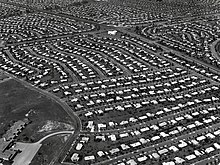The Crack in the Picture Window
During the post–World War II economic expansion of the late 1940s and the 1950s, many persons from rural and urban backgrounds moved to single-family detached homes in the suburbs or in horizontally developed cities.
Builders of housing developments offered no-down-payment options which baited people to become overly indebted for homes often poorly designed, cheaply made, and soul-numbingly identical.
At the same time, the social alienation of these neighborhoods, engendered by the replacement of the local markets with the supermarket, the inward-turning impetus of the television, and other changes, takes a psychological toll on the new suburbanites.
Surrounded by neighbors but not true friends, they try to ameliorate their plight with gadgets such as televisions—which sinks them deeper into debt—or various activities including neighborhood sex.
[2] Keats critique is sometimes acerbic, as when he claims that "whole square miles of identical boxes are spreading like gangrene" across America because for nothing down "other than a simple two percent and a promise to pay, and pay, and pay until the end of your life" a person can "find a box of your own in one of the fresh-air slums" being built, "developments conceived in error, nurtured by greed, corroding everything they touch" which besides their effect to "destroy established cities and trade patterns [and] pose dangerous problems for the areas they invade" also even "actually drive mad myriads of housewives shut up in them".
